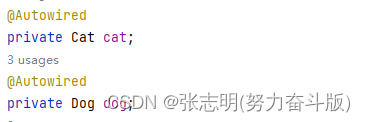Bean的装配可以理解为依赖关系注入,Bean的装配方式,即Bean的依赖注入方式,Spring容器支持多种形式的Bean的装配方式:
eg:
实体类 people、cat、dog
public class People {
private Cat cat;
private Dog dog;
private String name;
public Cat getCat() {
return cat;
}
public void setCat(Cat cat) {
this.cat = cat;
}
public Dog getDog() {
return dog;
}
public void setDog(Dog dog) {
this.dog = dog;
}
public String getName() {
return name;
}
public void setName(String name) {
this.name = name;
}
@Override
public String toString() {
return "People{" +
"cat=" + cat +
", dog=" + dog +
", name='" + name + '\'' +
'}';
}
}
public class Dog {
public void shut(){
System.out.println("wang~");
}
}
public class Cat {
public void shut(){
System.out.println("miao~");
}
}
在XML中显式配置(基于XML的装配) :
设值注入(Set方式注入)(Setter Injection)和构造器注入(Constructor Injection)在Spring实例化Bean的过程中,Spring首先会调用Bean的默认构造方法来实例化Bean对象,然后通过反射的方式调用setter()方法来注入属性值。因此,设值注入要求一个Bean必须满足要求:Bean类必须提供一个无参构造方法。
Bean类必须为需要注入的属性提供对应的setter()方法
设值注入:在配置文件中,需要使用 <property>元素为每个属性注入值
构造注入:在配置文件中,需要使用<constructor-arg>元素来定义构造方法的参数,也可以使用其value属性来设置该参数的值
Spring DI依赖注入_张志明(努力奋斗版)的博客-CSDN博客1.构造器注入如果只有一个有参数的构造方法并且参数类型与注入的bean的类型匹配,那就会注入到该构造方法中。要求类里要有有参构造。每个构造参数就是一个依赖项 详见下文中:使用有参数构造创建对象Spring IOC创建对象的方式_张志明(努力奋斗版)的博客-CSDN博客1.默认使用无参构造器创建对象 tips:要求实体类中不显示写出构造函数 或者 写出缺省的构造函数.xml <?xml version="1.0" encoding="UTF-8"?><beans xml...https://blog.csdn.net/TIANJIAWEN/article/details/124800270?spm=1001.2014.3001.5501
<?xml version="1.0" encoding="UTF-8"?>
<beans xmlns="http://www.springframework.org/schema/beans"
xmlns:xsi="http://www.w3.org/2001/XMLSchema-instance"
xsi:schemaLocation="http://www.springframework.org/schema/beans http://www.springframework.org/schema/beans/spring-beans.xsd">
<bean id="cat" class="com.kero.pojo.Cat"/>
<bean id="dog" class="com.kero.pojo.Dog"/>
<bean id="people" class="com.kero.pojo.People">
<property name="name" value="kk"/>
<property name="cat" ref="cat"/>
<property name="dog" ref="dog"/>
</bean>
</beans>自动装配
将一个Bean自动地注入到其他Bean的Property中
Spring的<bean>元素中包含一个autowired的属性,我们可以设置autowired的属性值来自动装配Bean
1.ByName自动装配
会自动在容器上下文中查找和自己对象set方法后面的值对应的bean id
tips:必须名字相同,但是set方法后面名字是大写,可以用小写,但是用大写不行
eg:public void setDog22(Dog dog) { this.dog = dog; }
<bean id="DOG22" class="com.kero.pojo.Dog"/> 这样不行
<bean id="dog22" class="com.kero.pojo.Dog"/>这样可以
<?xml version="1.0" encoding="UTF-8"?>
<beans xmlns="http://www.springframework.org/schema/beans"
xmlns:xsi="http://www.w3.org/2001/XMLSchema-instance"
xsi:schemaLocation="http://www.springframework.org/schema/beans http://www.springframework.org/schema/beans/spring-beans.xsd">
<bean id="cat" class="com.kero.pojo.Cat"/>
<bean id="dog" class="com.kero.pojo.Dog"/>
<bean id="people" class="com.kero.pojo.People" autowire="byName">
<property name="name" value="kk"/>
</bean>
</beans>2.ByType自动装配
会自动在容器上下文中查找,和自己对象属性类型相同的bean
tips:必须保证这个类型全局唯一,如果有两个相同的
可以省略id
eg:
<bean class="com.kero.pojo.Cat"/>
<bean class="com.kero.pojo.Dog"/>
3.使用注解实现自动装配
注解使用须知:
①导入约束 (导入context约束和两个约束的支持)
xmlns:context="http://www.springframework.org/schema/context"
约束的支持要写在xsi:schemaLocation=""引号中
http://www.springframework.org/schema/context
https://www.springframework.org/schema/context/spring-context.xsd
②配置注解的支持
<!--开启注解的支持-->
<context:annotation-config/> 即:
<?xml version="1.0" encoding="UTF-8"?>
<beans xmlns="http://www.springframework.org/schema/beans"
xmlns:xsi="http://www.w3.org/2001/XMLSchema-instance"
xmlns:context="http://www.springframework.org/schema/context"
xsi:schemaLocation="http://www.springframework.org/schema/beans
https://www.springframework.org/schema/beans/spring-beans.xsd
http://www.springframework.org/schema/context
https://www.springframework.org/schema/context/spring-context.xsd">
<!--开启注解的支持-->
<context:annotation-config/>
<bean id="cat" class="com.kero.pojo.Cat"/>
<bean id="dog" class="com.kero.pojo.Dog"/>
<bean id="people" class="com.kero.pojo.People"/>
</beans>
@Autowired 直接在属性上使用即可 (此时可以省略set方法)
package com.kero.pojo;
import org.springframework.beans.factory.annotation.Autowired;
public class People {
@Autowired
private Cat cat;
@Autowired
private Dog dog;
private String name;
public Cat getCat() {
return cat;
}
public Dog getDog() {
return dog;
}
public void setName(String name) {
this.name = name;
}
public String getName() {
return name;
}
@Override
public String toString() {
return "People{" +
"cat=" + cat +
", dog=" + dog +
", name='" + name + '\'' +
'}';
}
}
也可以在set方法上使用
import org.springframework.beans.factory.annotation.Autowired;
public class People {
private Cat cat;
private Dog dog;
private String name;
public Cat getCat() {
return cat;
}
@Autowired
public void setCat(Cat cat) {
this.cat = cat;
}
@Autowired
public void setDog(Dog dog) {
this.dog = dog;
}
public Dog getDog() {
return dog;
}
public void setName(String name) {
this.name = name;
}
public String getName() {
return name;
}
@Override
public String toString() {
return "People{" +
"cat=" + cat +
", dog=" + dog +
", name='" + name + '\'' +
'}';
}
}
//如果显示定义了required = false 说明这个对象可以为null 不显示定义的话 不能为null
@Autowired(required = false)
@Autowired 默认按照Bean的类型进行装配
@Qualifier:与@Autowired注解配合使用,会将默认的按Bean类型装配修改为Bean的实例名称装配,Bean的实例名称由 @Qualifier注解的参数指定
eg:此时不报错 因为默认按照Bean的类型进行装配
<bean id="cat1" class="com.kero.pojo.Cat"/>
<bean id="dog1" class="com.kero.pojo.Dog"/>
此时报错 匹配不到相同的 bean @Autowired是按类型自动装配的,不支持id匹配。
<bean id="cat2" class="com.kero.pojo.Cat"/>
<bean id="dog2" class="com.kero.pojo.Dog"/>
<bean id="cat1" class="com.kero.pojo.Cat"/>
<bean id="dog1" class="com.kero.pojo.Dog"/>

但是如果在people.java做如下更改 就不报错了
@Autowired
@Qualifier(value ="cat1")
private Cat cat;
@Autowired
@Qualifier(value ="dog1")
private Dog dog;
若@Autowired自动装配的环境比较复杂 自动装配无法通过一个注解@Autowired完成的时候 我们可以使用@Qualifier(value="XXX")去配置@Autowired的使用 指定唯一的bean对象注入
补充知识:
@Nullable 字段标记了这个注解 说明这个字段可以为null
@Resource
@Resource:其作用与@Autowired一样。其区别在于@Autowired默认Bean的类型装配,而@Resource默认按照Bean的实例名称进行装配
@Resource(name = "cat2")
private Cat cat;
@Resource(name = "dog2")
private Dog dog;<bean id="cat2" class="com.kero.pojo.Cat"/>
<bean id="dog2" class="com.kero.pojo.Dog"/>
<bean id="cat1" class="com.kero.pojo.Cat"/>
<bean id="dog1" class="com.kero.pojo.Dog"/>
@Resource VS @Autowired
·都是用来自动装配的都可以放在属性字段上
·@Autowired 通过byname的方式实现 而且必须要求这个对象存在
·@Resource 默认通过byName的方式实现 若找不到名字则通过byType实现
若两个都找不到 则报错!
·执行顺序不同@Autowired通过byname的方式实现@Resource 默认通过byName的方式实现






















 85
85











 被折叠的 条评论
为什么被折叠?
被折叠的 条评论
为什么被折叠?








